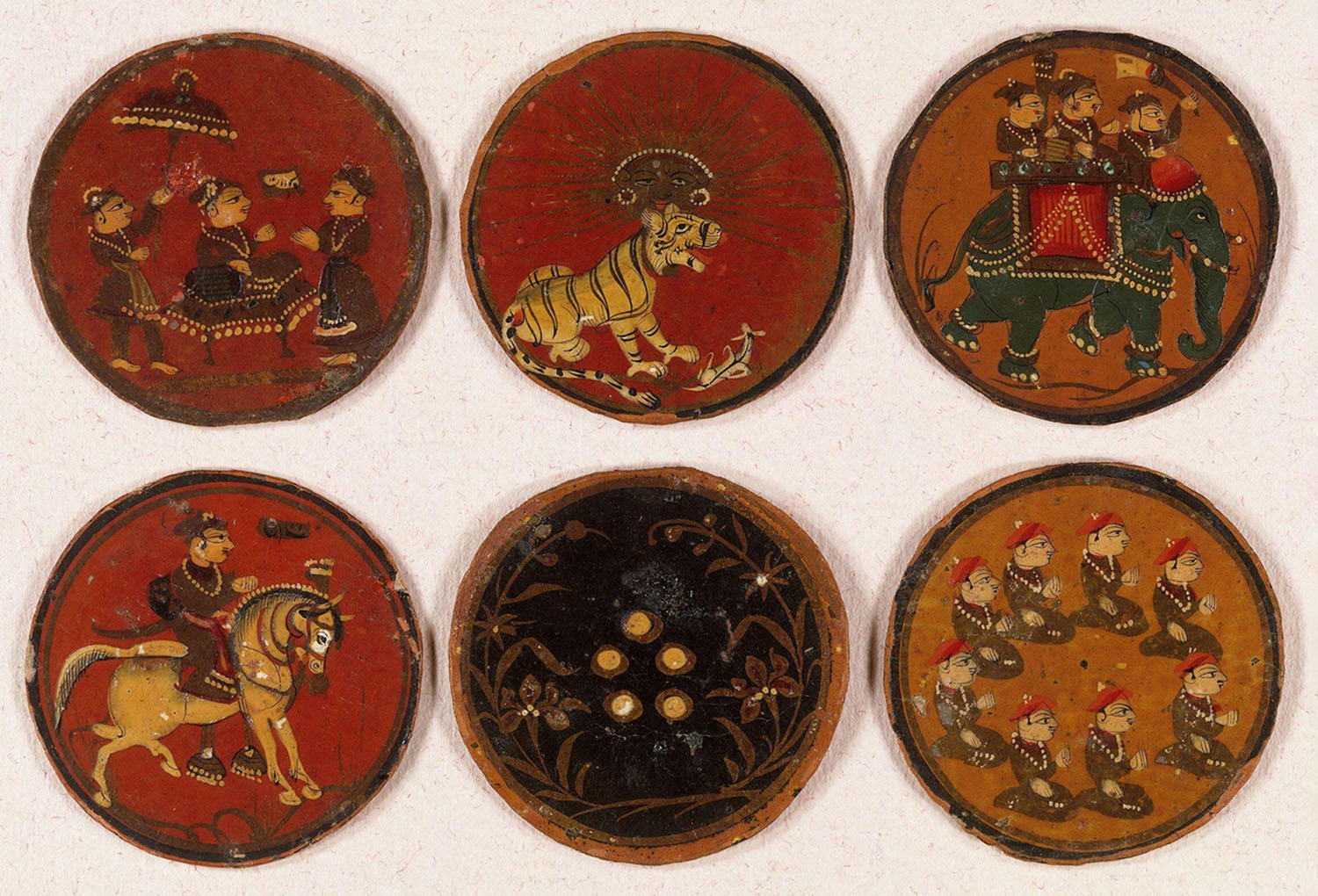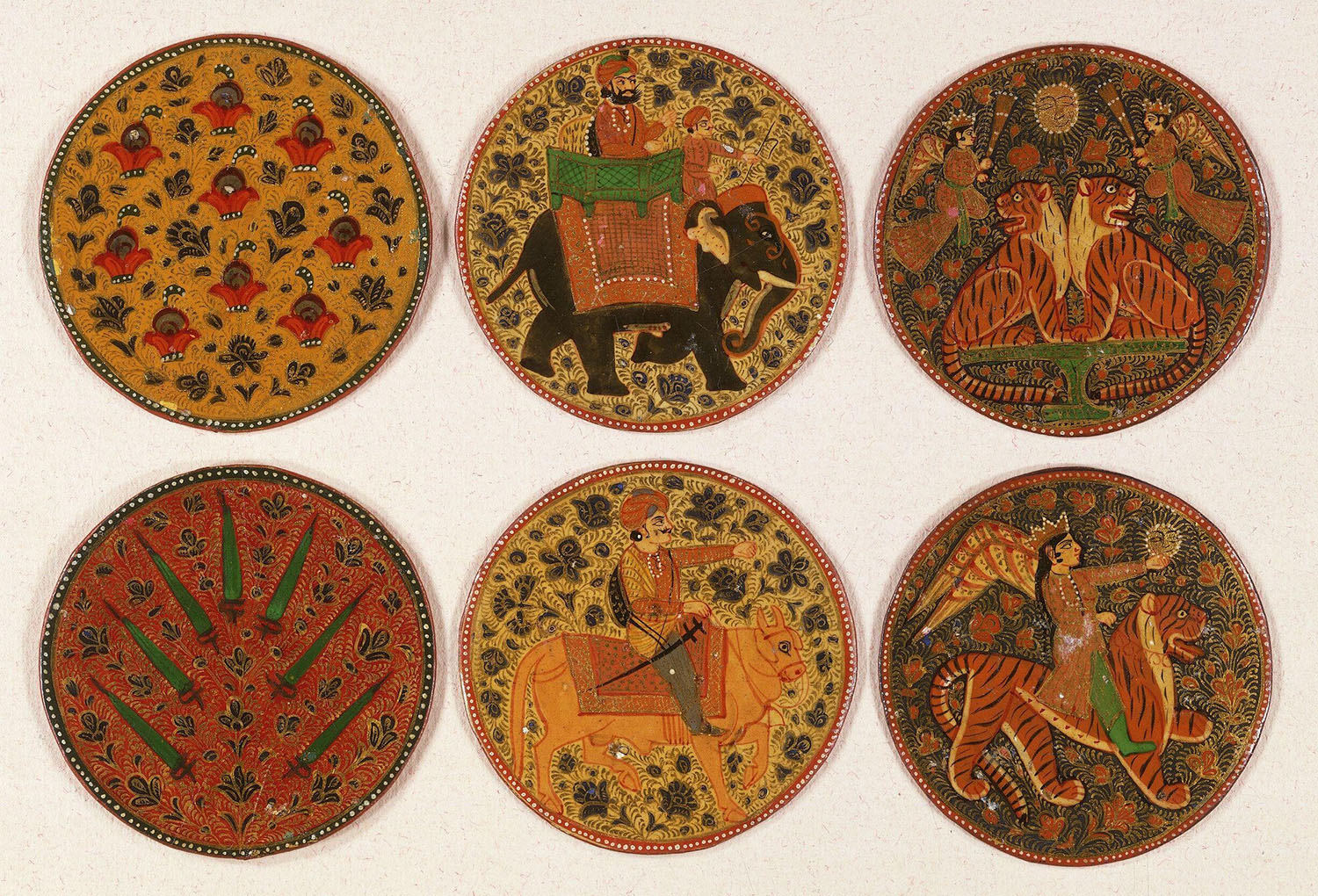ARTICLE
Akbar’s Ganjifa
A twelve-suited version of Ganjifa invented by the Mughal emperor Akbar in the mid-sixteenth century, Akbar’s Ganjifa is described in the Ain-i-Akbari, an account of Akbar’s rule written by his biographer Abu’l Fazl. While the gameplay and card structure within a suit appear to be the same as traditional Ganjifa, the suits themselves are entirely different.
In Ganjifa, each suit contains two court cards called shah (king) and wazir (minister), as well as numerical cards from one to ten. In Akbar’s version, the king card is also known as the amir.
The twelve suits of Akbar’s Ganjifa are: Horses, Elephants, Infantry, Treasures, Warriors, Ships, Women, Gods, Demons, Wild Beasts and Serpents. The first eight of these twelve suits not only roughly correspond to the administrative structure of the Mughal Empire at the time, but may also have a commemorative aspect in their depiction of the empire’s political landscape during Akbar’s rule. The remaining four suits are more mythological in nature. While the king cards of the suits are all distinct, the minister cards are mostly shown seated on a chandeli (a type of footstool), with a few exceptions.
The first three suits – Horses, Elephants and Infantry – are believed to be representative of Akbar, his viceroy in eastern India and his viceroy in southern India respectively. In the suit of Horses, the king is ashwapati, lord of horses and the ruler of Delhi, while the minister is seated on a horse. In the suit of Elephants – whose minister is shown atop an elephant – the king is gajapati, lord of elephants and vassal ruler of what is now Odisha. Similarly, the third suit of Infantry has narpati, lord of men and the vassal ruler of Bijapur, as its king.
The next five suits depict other aspects of the emperor’s court. The suit of Treasures comprises pots full of gold coins, with the image of a dhanpati (lord of treasures) as its king. The king of the suit of Forts is garhpati (lord of forts). The suit of Warriors has dalpati, the lord of war, as its king, who is shown to be surrounded by warriors in armour. The minister of this suit is also depicted wearing armour. The suit of Ships has navpati (lord of the fleet) as king, who is shown atop a throne on a ship. An exception is the suit of Women, or the zenana, which has a female amir as well as a female wazir.
The suit of Gods or sura features the Hindu god Indra as its king, while the king of the suit of Demons or asura is shown to be Suleiman (or Solomon), who was believed to have control over jinn in Islamic mythology. In his account, however, Abu’l Fazl states that the image on this card also bore the likeness of Daud Khan Karrani, the erstwhile ruler of Bengal and Bihar who had been defeated by Akbar.
The suit of Wild Beasts or van has a tiger as its king, surrounded by other animals, while its minister takes the form of a leopard. The twelfth and final suit, of Serpents or ahi, has a large snake riding a dragon as its king and a snake riding another snake as its minister.
Abu’l Fazl also attributes another eight-suited game to Akbar, but its existence has not been corroborated by any material evidence.
Bibliography
Our website is currently undergoing maintenance and re-design, due to which we have had to take down some of our bibliographies. While these will be re-published shortly, you can request references for specific articles by writing to hellomapacademy@map-india.org.







![The façade of the Maneckji Seth Agiary, a Zoroastrian fire temple, is a standout example of the popularity of the Persian Revival Style in Western India in the 19th and 20th centuries. This style was often seen in the architectural patronage of the Parsis, who emerged as one of the most influential mercantile communities of British India. Popular motifs of this style, like the mythical lamasus (winged bulls with human heads) and the faravahar (a winged guardian spirit in Zoroastrianism), drew on the historical art and architecture of the Achaemenid and Sasanian empires from sites like Persepolis, Bisotun, Taq-e Bostan, Naqsh-e Rostam and Naqsh-e Rajab in Persia.
The Parsi community’s adoption of this style occurred largely due to their networks of global commerce and politics, allowing them to access and translate research of ancient Persia into visible symbols that underlined their association with antiquity, imperial power, and art.
نمای آتشکدهی زرتشتی مانِکجی سِت نمونهی بارزی از رواج سبک «احیای [معماری] ایرانی» در غرب هند طی سدههای نوزدهم و بیستم است. این سبک غالباً در بناهایی دیده میشد که پارسیان، از بانفوذترین جوامع بازرگان در هند بریتانیا، بانیشان بودند. نقشمایههای محبوب این سبک، مانند گاو بالدار اساطیری (لاماسو) و فَروَهَر (روح بالدار نگهبان در دین زرتشت)، برگرفته از هنر و معماری شاهنشاهی هخامنشی و ساسانی، در جاهایی چون تخت جمشید و بیستون و طاق بستان و نقش رستم و نقش رجب، بود.
اقتباس جامعهی پارسیان از این سبک بسیار مرهون روابط گستردهی تجاری و سیاسی آنها بود که دسترس به پژوهشها دربارهی ایران باستان و برگردانیدن آنها به نمادهای بصری را ممکن میکرد و بر پیوند پارسیان با دوران باستان و قدرت شاهنشاهی و هنر تأکید میکرد.](https://mapacademy.io/wp-content/plugins/instagram-feed/img/placeholder.png)
